Business Communication: Negotiation, Presentation, and Documents
VerifiedAdded on 2020/07/22
|10
|2748
|47
Report
AI Summary
This report provides a comprehensive overview of the principles of business communication. It begins by exploring the importance of negotiation in a business environment, detailing various approaches such as distributive, lose-lose, compromise, and win-win strategies, along with key negotiation tactics. The report then delves into different types of presentations, resources used, methods of delivery, and best practices for delivering presentations, including collecting and using feedback. Furthermore, it examines bespoke documents, covering their characteristics, creation factors, legal requirements, techniques, and approval processes. Finally, the report discusses the stages, benefits, limitations, and legal considerations of information system development, providing a thorough understanding of effective business communication strategies.
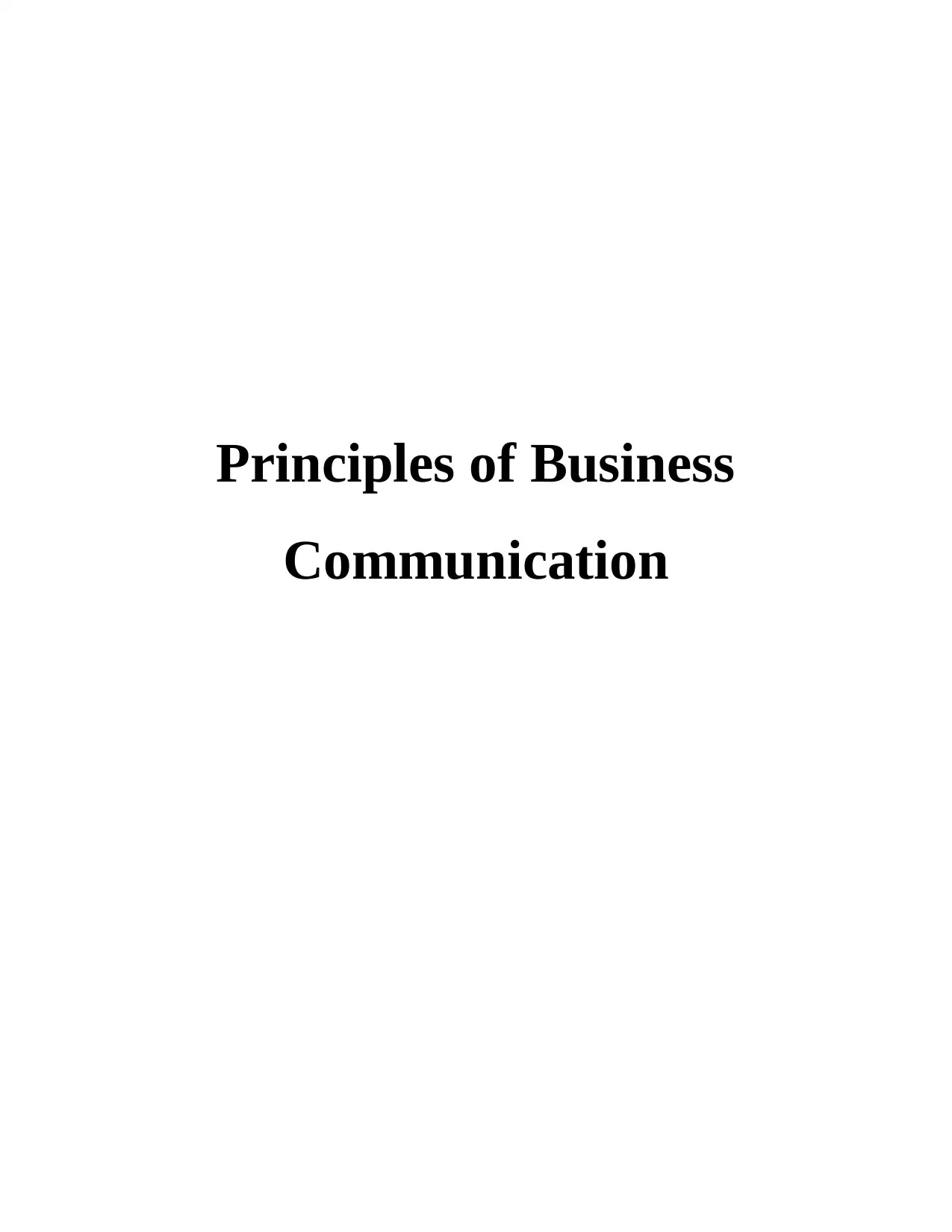
Principles of Business
Communication
Communication
Paraphrase This Document
Need a fresh take? Get an instant paraphrase of this document with our AI Paraphraser
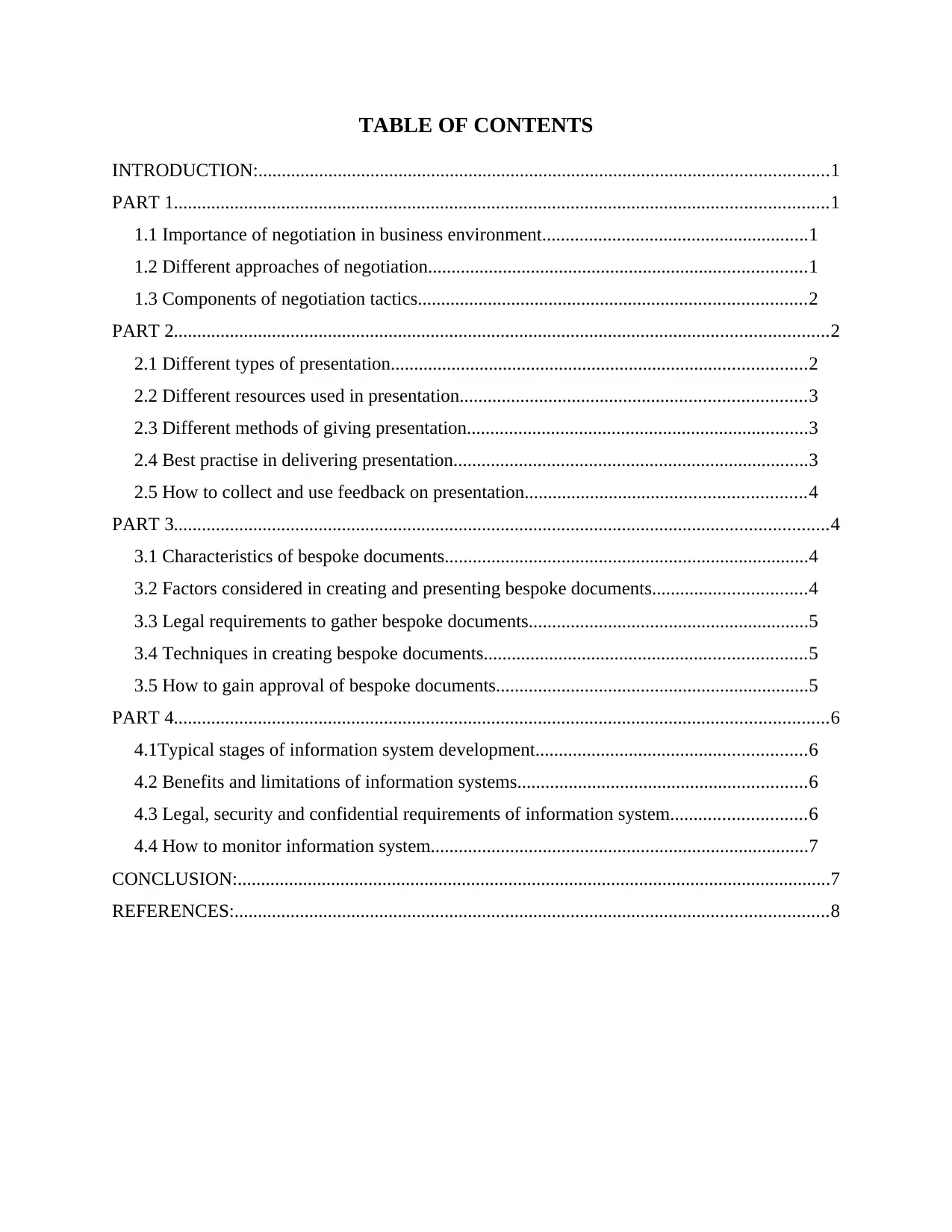
TABLE OF CONTENTS
INTRODUCTION:..........................................................................................................................1
PART 1............................................................................................................................................1
1.1 Importance of negotiation in business environment.........................................................1
1.2 Different approaches of negotiation.................................................................................1
1.3 Components of negotiation tactics...................................................................................2
PART 2............................................................................................................................................2
2.1 Different types of presentation.........................................................................................2
2.2 Different resources used in presentation..........................................................................3
2.3 Different methods of giving presentation.........................................................................3
2.4 Best practise in delivering presentation............................................................................3
2.5 How to collect and use feedback on presentation............................................................4
PART 3............................................................................................................................................4
3.1 Characteristics of bespoke documents..............................................................................4
3.2 Factors considered in creating and presenting bespoke documents.................................4
3.3 Legal requirements to gather bespoke documents............................................................5
3.4 Techniques in creating bespoke documents.....................................................................5
3.5 How to gain approval of bespoke documents...................................................................5
PART 4............................................................................................................................................6
4.1Typical stages of information system development..........................................................6
4.2 Benefits and limitations of information systems..............................................................6
4.3 Legal, security and confidential requirements of information system.............................6
4.4 How to monitor information system.................................................................................7
CONCLUSION:...............................................................................................................................7
REFERENCES:...............................................................................................................................8
INTRODUCTION:..........................................................................................................................1
PART 1............................................................................................................................................1
1.1 Importance of negotiation in business environment.........................................................1
1.2 Different approaches of negotiation.................................................................................1
1.3 Components of negotiation tactics...................................................................................2
PART 2............................................................................................................................................2
2.1 Different types of presentation.........................................................................................2
2.2 Different resources used in presentation..........................................................................3
2.3 Different methods of giving presentation.........................................................................3
2.4 Best practise in delivering presentation............................................................................3
2.5 How to collect and use feedback on presentation............................................................4
PART 3............................................................................................................................................4
3.1 Characteristics of bespoke documents..............................................................................4
3.2 Factors considered in creating and presenting bespoke documents.................................4
3.3 Legal requirements to gather bespoke documents............................................................5
3.4 Techniques in creating bespoke documents.....................................................................5
3.5 How to gain approval of bespoke documents...................................................................5
PART 4............................................................................................................................................6
4.1Typical stages of information system development..........................................................6
4.2 Benefits and limitations of information systems..............................................................6
4.3 Legal, security and confidential requirements of information system.............................6
4.4 How to monitor information system.................................................................................7
CONCLUSION:...............................................................................................................................7
REFERENCES:...............................................................................................................................8
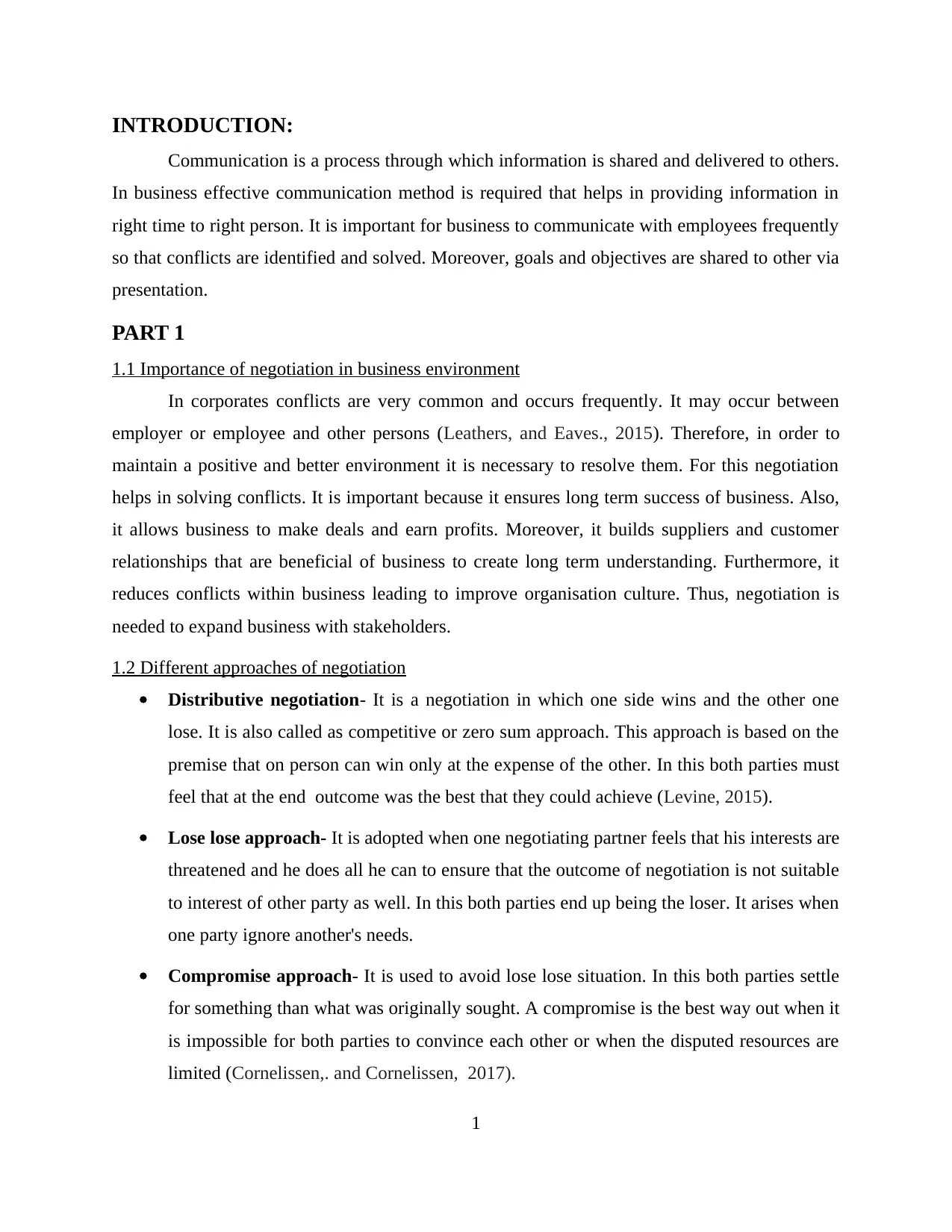
INTRODUCTION:
Communication is a process through which information is shared and delivered to others.
In business effective communication method is required that helps in providing information in
right time to right person. It is important for business to communicate with employees frequently
so that conflicts are identified and solved. Moreover, goals and objectives are shared to other via
presentation.
PART 1
1.1 Importance of negotiation in business environment
In corporates conflicts are very common and occurs frequently. It may occur between
employer or employee and other persons (Leathers, and Eaves., 2015). Therefore, in order to
maintain a positive and better environment it is necessary to resolve them. For this negotiation
helps in solving conflicts. It is important because it ensures long term success of business. Also,
it allows business to make deals and earn profits. Moreover, it builds suppliers and customer
relationships that are beneficial of business to create long term understanding. Furthermore, it
reduces conflicts within business leading to improve organisation culture. Thus, negotiation is
needed to expand business with stakeholders.
1.2 Different approaches of negotiation
Distributive negotiation- It is a negotiation in which one side wins and the other one
lose. It is also called as competitive or zero sum approach. This approach is based on the
premise that on person can win only at the expense of the other. In this both parties must
feel that at the end outcome was the best that they could achieve (Levine, 2015).
Lose lose approach- It is adopted when one negotiating partner feels that his interests are
threatened and he does all he can to ensure that the outcome of negotiation is not suitable
to interest of other party as well. In this both parties end up being the loser. It arises when
one party ignore another's needs.
Compromise approach- It is used to avoid lose lose situation. In this both parties settle
for something than what was originally sought. A compromise is the best way out when it
is impossible for both parties to convince each other or when the disputed resources are
limited (Cornelissen,. and Cornelissen, 2017).
1
Communication is a process through which information is shared and delivered to others.
In business effective communication method is required that helps in providing information in
right time to right person. It is important for business to communicate with employees frequently
so that conflicts are identified and solved. Moreover, goals and objectives are shared to other via
presentation.
PART 1
1.1 Importance of negotiation in business environment
In corporates conflicts are very common and occurs frequently. It may occur between
employer or employee and other persons (Leathers, and Eaves., 2015). Therefore, in order to
maintain a positive and better environment it is necessary to resolve them. For this negotiation
helps in solving conflicts. It is important because it ensures long term success of business. Also,
it allows business to make deals and earn profits. Moreover, it builds suppliers and customer
relationships that are beneficial of business to create long term understanding. Furthermore, it
reduces conflicts within business leading to improve organisation culture. Thus, negotiation is
needed to expand business with stakeholders.
1.2 Different approaches of negotiation
Distributive negotiation- It is a negotiation in which one side wins and the other one
lose. It is also called as competitive or zero sum approach. This approach is based on the
premise that on person can win only at the expense of the other. In this both parties must
feel that at the end outcome was the best that they could achieve (Levine, 2015).
Lose lose approach- It is adopted when one negotiating partner feels that his interests are
threatened and he does all he can to ensure that the outcome of negotiation is not suitable
to interest of other party as well. In this both parties end up being the loser. It arises when
one party ignore another's needs.
Compromise approach- It is used to avoid lose lose situation. In this both parties settle
for something than what was originally sought. A compromise is the best way out when it
is impossible for both parties to convince each other or when the disputed resources are
limited (Cornelissen,. and Cornelissen, 2017).
1
⊘ This is a preview!⊘
Do you want full access?
Subscribe today to unlock all pages.

Trusted by 1+ million students worldwide
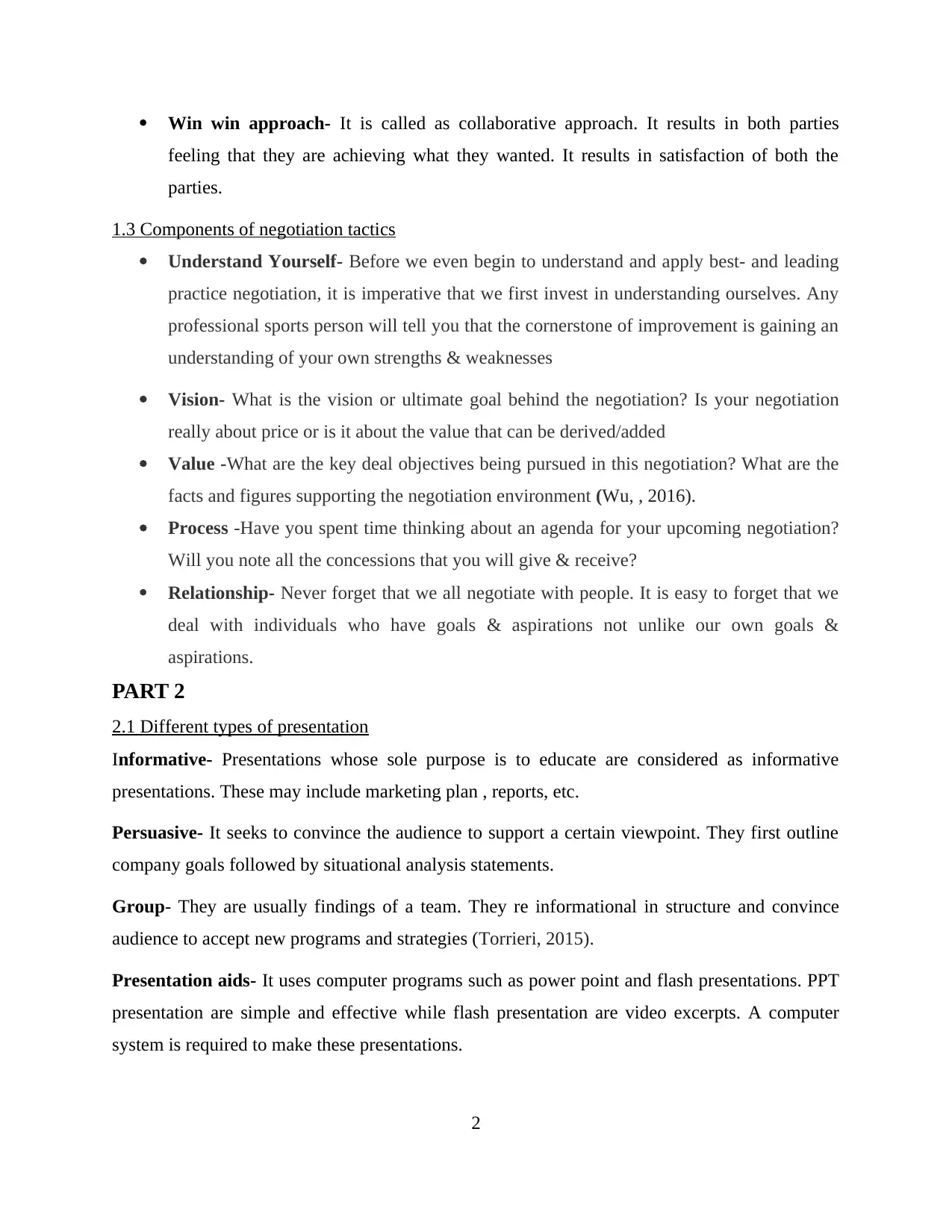
Win win approach- It is called as collaborative approach. It results in both parties
feeling that they are achieving what they wanted. It results in satisfaction of both the
parties.
1.3 Components of negotiation tactics
Understand Yourself- Before we even begin to understand and apply best- and leading
practice negotiation, it is imperative that we first invest in understanding ourselves. Any
professional sports person will tell you that the cornerstone of improvement is gaining an
understanding of your own strengths & weaknesses
Vision- What is the vision or ultimate goal behind the negotiation? Is your negotiation
really about price or is it about the value that can be derived/added
Value -What are the key deal objectives being pursued in this negotiation? What are the
facts and figures supporting the negotiation environment (Wu, , 2016).
Process -Have you spent time thinking about an agenda for your upcoming negotiation?
Will you note all the concessions that you will give & receive?
Relationship- Never forget that we all negotiate with people. It is easy to forget that we
deal with individuals who have goals & aspirations not unlike our own goals &
aspirations.
PART 2
2.1 Different types of presentation
Informative- Presentations whose sole purpose is to educate are considered as informative
presentations. These may include marketing plan , reports, etc.
Persuasive- It seeks to convince the audience to support a certain viewpoint. They first outline
company goals followed by situational analysis statements.
Group- They are usually findings of a team. They re informational in structure and convince
audience to accept new programs and strategies (Torrieri, 2015).
Presentation aids- It uses computer programs such as power point and flash presentations. PPT
presentation are simple and effective while flash presentation are video excerpts. A computer
system is required to make these presentations.
2
feeling that they are achieving what they wanted. It results in satisfaction of both the
parties.
1.3 Components of negotiation tactics
Understand Yourself- Before we even begin to understand and apply best- and leading
practice negotiation, it is imperative that we first invest in understanding ourselves. Any
professional sports person will tell you that the cornerstone of improvement is gaining an
understanding of your own strengths & weaknesses
Vision- What is the vision or ultimate goal behind the negotiation? Is your negotiation
really about price or is it about the value that can be derived/added
Value -What are the key deal objectives being pursued in this negotiation? What are the
facts and figures supporting the negotiation environment (Wu, , 2016).
Process -Have you spent time thinking about an agenda for your upcoming negotiation?
Will you note all the concessions that you will give & receive?
Relationship- Never forget that we all negotiate with people. It is easy to forget that we
deal with individuals who have goals & aspirations not unlike our own goals &
aspirations.
PART 2
2.1 Different types of presentation
Informative- Presentations whose sole purpose is to educate are considered as informative
presentations. These may include marketing plan , reports, etc.
Persuasive- It seeks to convince the audience to support a certain viewpoint. They first outline
company goals followed by situational analysis statements.
Group- They are usually findings of a team. They re informational in structure and convince
audience to accept new programs and strategies (Torrieri, 2015).
Presentation aids- It uses computer programs such as power point and flash presentations. PPT
presentation are simple and effective while flash presentation are video excerpts. A computer
system is required to make these presentations.
2
Paraphrase This Document
Need a fresh take? Get an instant paraphrase of this document with our AI Paraphraser
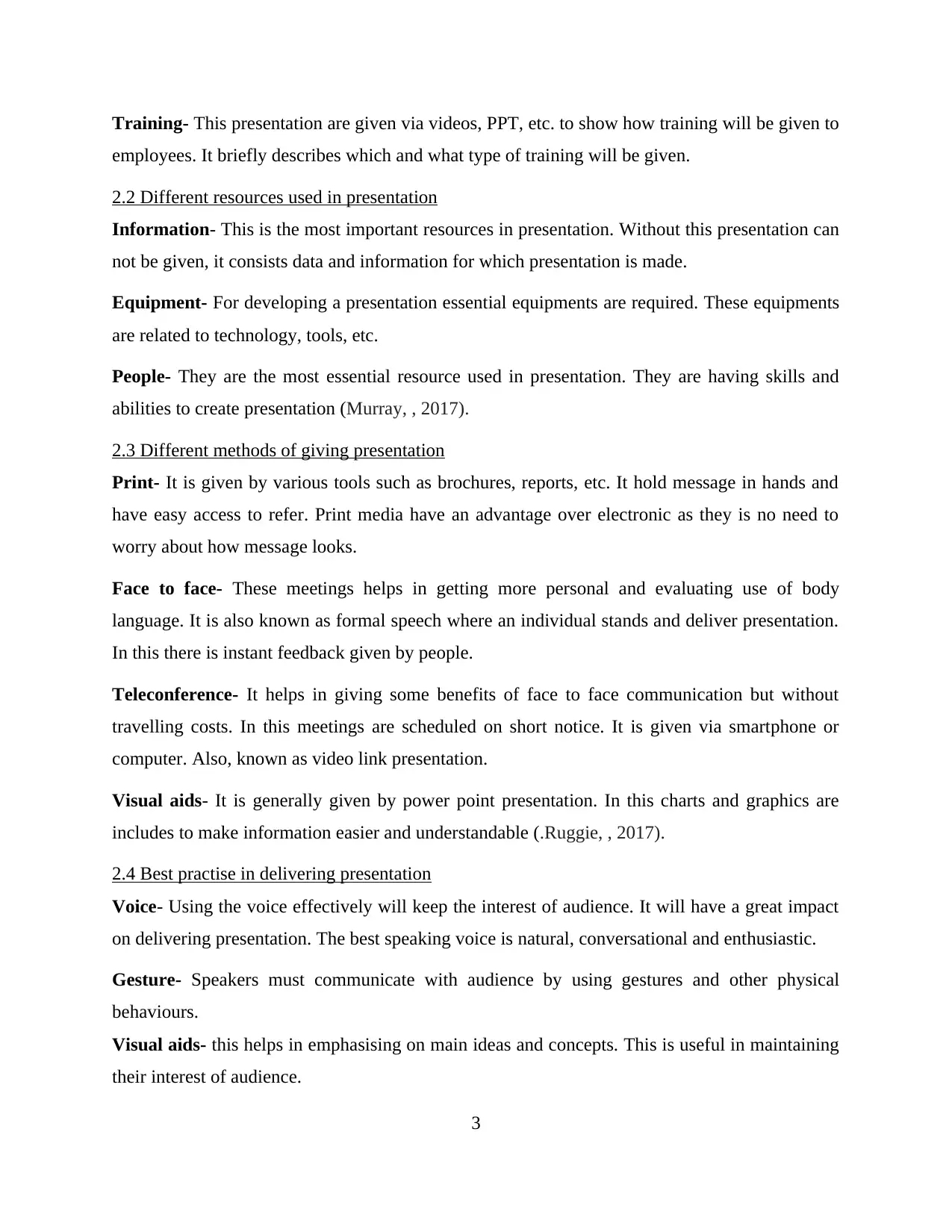
Training- This presentation are given via videos, PPT, etc. to show how training will be given to
employees. It briefly describes which and what type of training will be given.
2.2 Different resources used in presentation
Information- This is the most important resources in presentation. Without this presentation can
not be given, it consists data and information for which presentation is made.
Equipment- For developing a presentation essential equipments are required. These equipments
are related to technology, tools, etc.
People- They are the most essential resource used in presentation. They are having skills and
abilities to create presentation (Murray, , 2017).
2.3 Different methods of giving presentation
Print- It is given by various tools such as brochures, reports, etc. It hold message in hands and
have easy access to refer. Print media have an advantage over electronic as they is no need to
worry about how message looks.
Face to face- These meetings helps in getting more personal and evaluating use of body
language. It is also known as formal speech where an individual stands and deliver presentation.
In this there is instant feedback given by people.
Teleconference- It helps in giving some benefits of face to face communication but without
travelling costs. In this meetings are scheduled on short notice. It is given via smartphone or
computer. Also, known as video link presentation.
Visual aids- It is generally given by power point presentation. In this charts and graphics are
includes to make information easier and understandable (.Ruggie, , 2017).
2.4 Best practise in delivering presentation
Voice- Using the voice effectively will keep the interest of audience. It will have a great impact
on delivering presentation. The best speaking voice is natural, conversational and enthusiastic.
Gesture- Speakers must communicate with audience by using gestures and other physical
behaviours.
Visual aids- this helps in emphasising on main ideas and concepts. This is useful in maintaining
their interest of audience.
3
employees. It briefly describes which and what type of training will be given.
2.2 Different resources used in presentation
Information- This is the most important resources in presentation. Without this presentation can
not be given, it consists data and information for which presentation is made.
Equipment- For developing a presentation essential equipments are required. These equipments
are related to technology, tools, etc.
People- They are the most essential resource used in presentation. They are having skills and
abilities to create presentation (Murray, , 2017).
2.3 Different methods of giving presentation
Print- It is given by various tools such as brochures, reports, etc. It hold message in hands and
have easy access to refer. Print media have an advantage over electronic as they is no need to
worry about how message looks.
Face to face- These meetings helps in getting more personal and evaluating use of body
language. It is also known as formal speech where an individual stands and deliver presentation.
In this there is instant feedback given by people.
Teleconference- It helps in giving some benefits of face to face communication but without
travelling costs. In this meetings are scheduled on short notice. It is given via smartphone or
computer. Also, known as video link presentation.
Visual aids- It is generally given by power point presentation. In this charts and graphics are
includes to make information easier and understandable (.Ruggie, , 2017).
2.4 Best practise in delivering presentation
Voice- Using the voice effectively will keep the interest of audience. It will have a great impact
on delivering presentation. The best speaking voice is natural, conversational and enthusiastic.
Gesture- Speakers must communicate with audience by using gestures and other physical
behaviours.
Visual aids- this helps in emphasising on main ideas and concepts. This is useful in maintaining
their interest of audience.
3
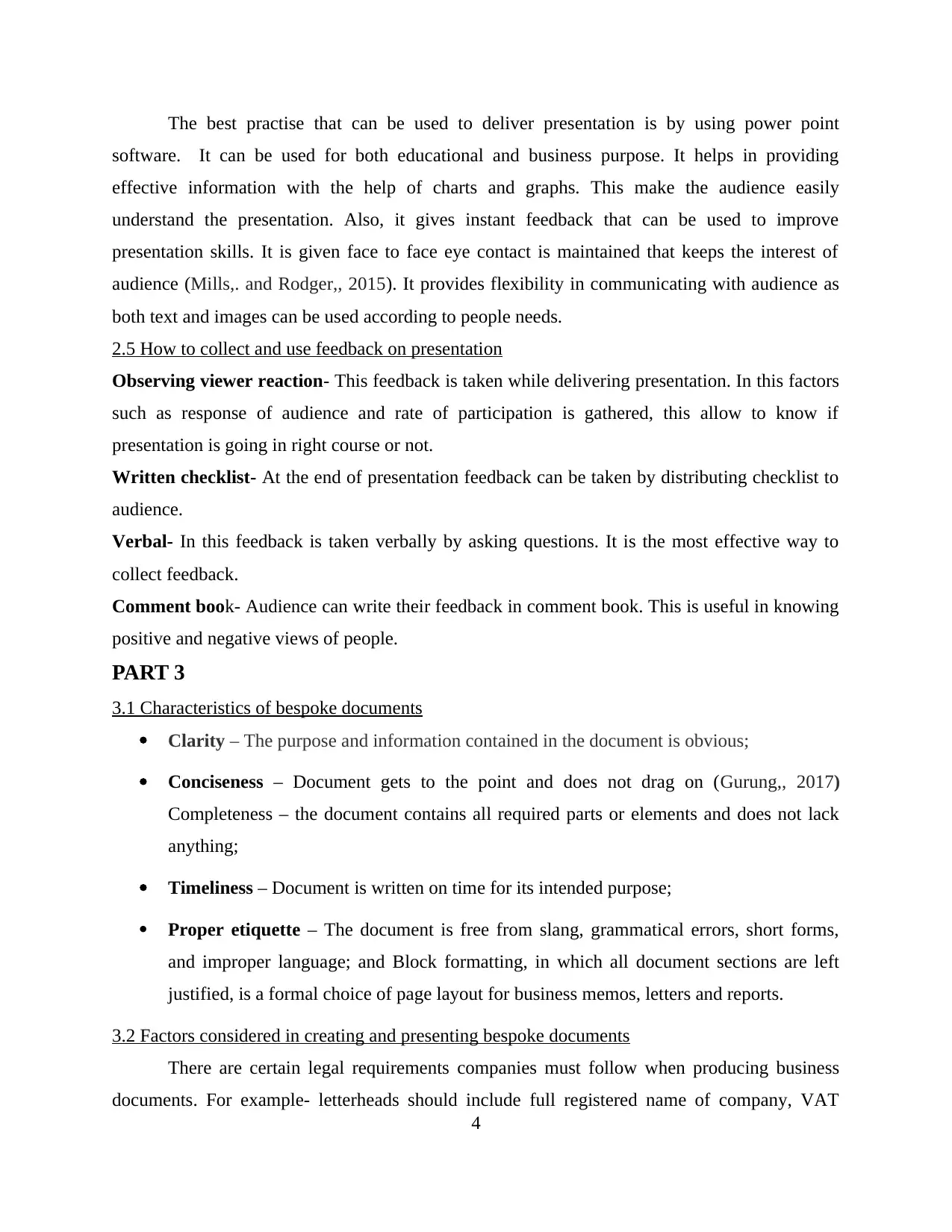
The best practise that can be used to deliver presentation is by using power point
software. It can be used for both educational and business purpose. It helps in providing
effective information with the help of charts and graphs. This make the audience easily
understand the presentation. Also, it gives instant feedback that can be used to improve
presentation skills. It is given face to face eye contact is maintained that keeps the interest of
audience (Mills,. and Rodger,, 2015). It provides flexibility in communicating with audience as
both text and images can be used according to people needs.
2.5 How to collect and use feedback on presentation
Observing viewer reaction- This feedback is taken while delivering presentation. In this factors
such as response of audience and rate of participation is gathered, this allow to know if
presentation is going in right course or not.
Written checklist- At the end of presentation feedback can be taken by distributing checklist to
audience.
Verbal- In this feedback is taken verbally by asking questions. It is the most effective way to
collect feedback.
Comment book- Audience can write their feedback in comment book. This is useful in knowing
positive and negative views of people.
PART 3
3.1 Characteristics of bespoke documents
Clarity – The purpose and information contained in the document is obvious;
Conciseness – Document gets to the point and does not drag on (Gurung,, 2017)
Completeness – the document contains all required parts or elements and does not lack
anything;
Timeliness – Document is written on time for its intended purpose;
Proper etiquette – The document is free from slang, grammatical errors, short forms,
and improper language; and Block formatting, in which all document sections are left
justified, is a formal choice of page layout for business memos, letters and reports.
3.2 Factors considered in creating and presenting bespoke documents
There are certain legal requirements companies must follow when producing business
documents. For example- letterheads should include full registered name of company, VAT
4
software. It can be used for both educational and business purpose. It helps in providing
effective information with the help of charts and graphs. This make the audience easily
understand the presentation. Also, it gives instant feedback that can be used to improve
presentation skills. It is given face to face eye contact is maintained that keeps the interest of
audience (Mills,. and Rodger,, 2015). It provides flexibility in communicating with audience as
both text and images can be used according to people needs.
2.5 How to collect and use feedback on presentation
Observing viewer reaction- This feedback is taken while delivering presentation. In this factors
such as response of audience and rate of participation is gathered, this allow to know if
presentation is going in right course or not.
Written checklist- At the end of presentation feedback can be taken by distributing checklist to
audience.
Verbal- In this feedback is taken verbally by asking questions. It is the most effective way to
collect feedback.
Comment book- Audience can write their feedback in comment book. This is useful in knowing
positive and negative views of people.
PART 3
3.1 Characteristics of bespoke documents
Clarity – The purpose and information contained in the document is obvious;
Conciseness – Document gets to the point and does not drag on (Gurung,, 2017)
Completeness – the document contains all required parts or elements and does not lack
anything;
Timeliness – Document is written on time for its intended purpose;
Proper etiquette – The document is free from slang, grammatical errors, short forms,
and improper language; and Block formatting, in which all document sections are left
justified, is a formal choice of page layout for business memos, letters and reports.
3.2 Factors considered in creating and presenting bespoke documents
There are certain legal requirements companies must follow when producing business
documents. For example- letterheads should include full registered name of company, VAT
4
⊘ This is a preview!⊘
Do you want full access?
Subscribe today to unlock all pages.

Trusted by 1+ million students worldwide
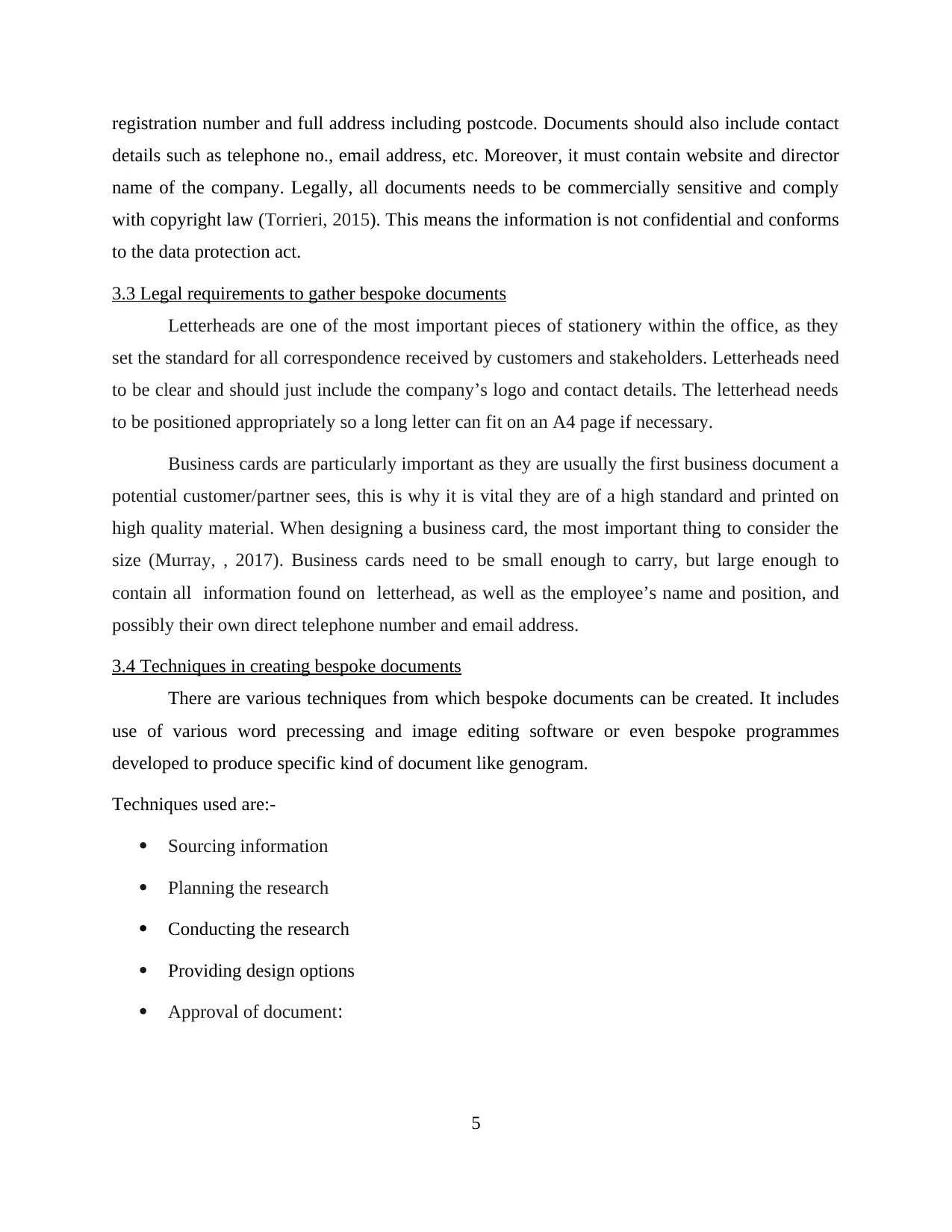
registration number and full address including postcode. Documents should also include contact
details such as telephone no., email address, etc. Moreover, it must contain website and director
name of the company. Legally, all documents needs to be commercially sensitive and comply
with copyright law (Torrieri, 2015). This means the information is not confidential and conforms
to the data protection act.
3.3 Legal requirements to gather bespoke documents
Letterheads are one of the most important pieces of stationery within the office, as they
set the standard for all correspondence received by customers and stakeholders. Letterheads need
to be clear and should just include the company’s logo and contact details. The letterhead needs
to be positioned appropriately so a long letter can fit on an A4 page if necessary.
Business cards are particularly important as they are usually the first business document a
potential customer/partner sees, this is why it is vital they are of a high standard and printed on
high quality material. When designing a business card, the most important thing to consider the
size (Murray, , 2017). Business cards need to be small enough to carry, but large enough to
contain all information found on letterhead, as well as the employee’s name and position, and
possibly their own direct telephone number and email address.
3.4 Techniques in creating bespoke documents
There are various techniques from which bespoke documents can be created. It includes
use of various word precessing and image editing software or even bespoke programmes
developed to produce specific kind of document like genogram.
Techniques used are:-
Sourcing information
Planning the research
Conducting the research
Providing design options
Approval of document:
5
details such as telephone no., email address, etc. Moreover, it must contain website and director
name of the company. Legally, all documents needs to be commercially sensitive and comply
with copyright law (Torrieri, 2015). This means the information is not confidential and conforms
to the data protection act.
3.3 Legal requirements to gather bespoke documents
Letterheads are one of the most important pieces of stationery within the office, as they
set the standard for all correspondence received by customers and stakeholders. Letterheads need
to be clear and should just include the company’s logo and contact details. The letterhead needs
to be positioned appropriately so a long letter can fit on an A4 page if necessary.
Business cards are particularly important as they are usually the first business document a
potential customer/partner sees, this is why it is vital they are of a high standard and printed on
high quality material. When designing a business card, the most important thing to consider the
size (Murray, , 2017). Business cards need to be small enough to carry, but large enough to
contain all information found on letterhead, as well as the employee’s name and position, and
possibly their own direct telephone number and email address.
3.4 Techniques in creating bespoke documents
There are various techniques from which bespoke documents can be created. It includes
use of various word precessing and image editing software or even bespoke programmes
developed to produce specific kind of document like genogram.
Techniques used are:-
Sourcing information
Planning the research
Conducting the research
Providing design options
Approval of document:
5
Paraphrase This Document
Need a fresh take? Get an instant paraphrase of this document with our AI Paraphraser
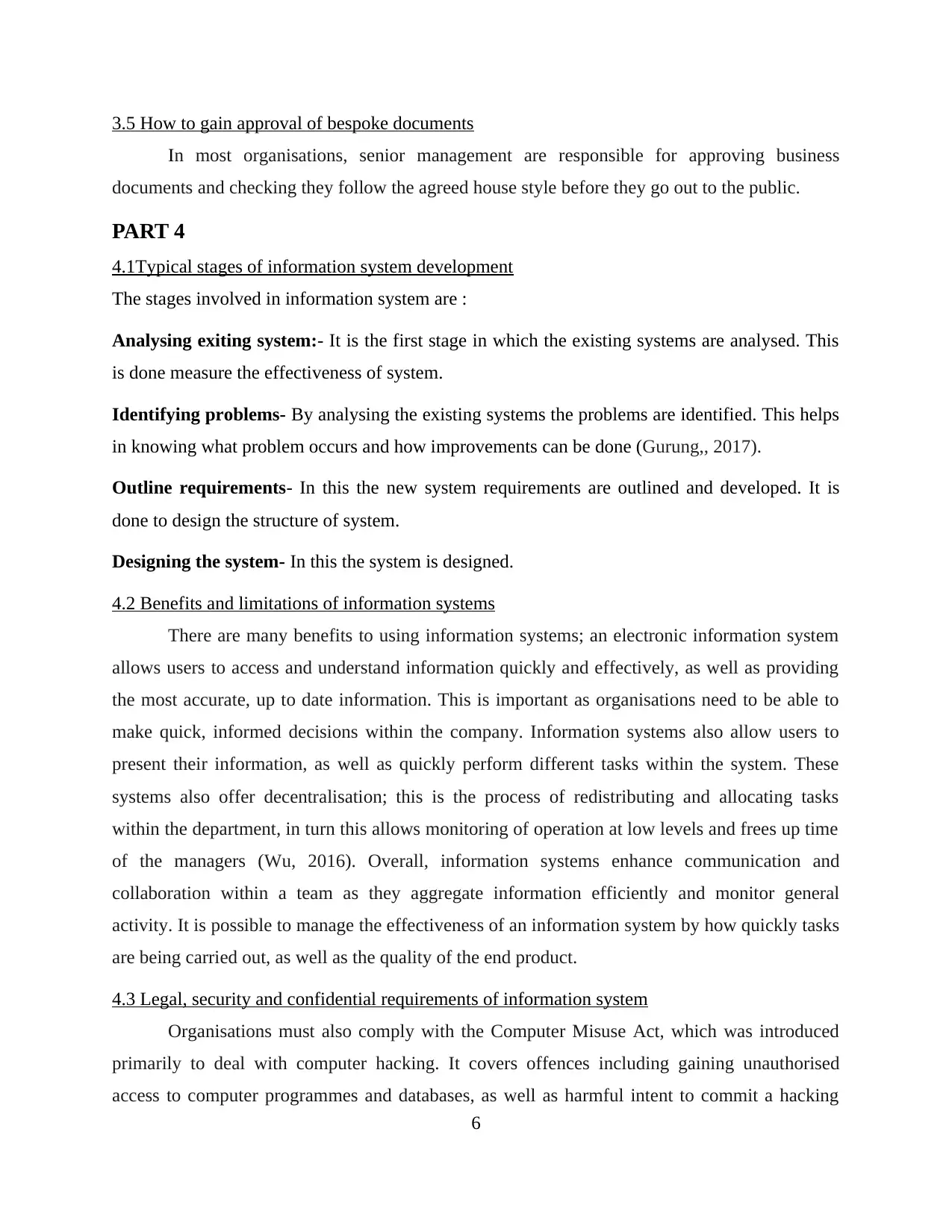
3.5 How to gain approval of bespoke documents
In most organisations, senior management are responsible for approving business
documents and checking they follow the agreed house style before they go out to the public.
PART 4
4.1Typical stages of information system development
The stages involved in information system are :
Analysing exiting system:- It is the first stage in which the existing systems are analysed. This
is done measure the effectiveness of system.
Identifying problems- By analysing the existing systems the problems are identified. This helps
in knowing what problem occurs and how improvements can be done (Gurung,, 2017).
Outline requirements- In this the new system requirements are outlined and developed. It is
done to design the structure of system.
Designing the system- In this the system is designed.
4.2 Benefits and limitations of information systems
There are many benefits to using information systems; an electronic information system
allows users to access and understand information quickly and effectively, as well as providing
the most accurate, up to date information. This is important as organisations need to be able to
make quick, informed decisions within the company. Information systems also allow users to
present their information, as well as quickly perform different tasks within the system. These
systems also offer decentralisation; this is the process of redistributing and allocating tasks
within the department, in turn this allows monitoring of operation at low levels and frees up time
of the managers (Wu, 2016). Overall, information systems enhance communication and
collaboration within a team as they aggregate information efficiently and monitor general
activity. It is possible to manage the effectiveness of an information system by how quickly tasks
are being carried out, as well as the quality of the end product.
4.3 Legal, security and confidential requirements of information system
Organisations must also comply with the Computer Misuse Act, which was introduced
primarily to deal with computer hacking. It covers offences including gaining unauthorised
access to computer programmes and databases, as well as harmful intent to commit a hacking
6
In most organisations, senior management are responsible for approving business
documents and checking they follow the agreed house style before they go out to the public.
PART 4
4.1Typical stages of information system development
The stages involved in information system are :
Analysing exiting system:- It is the first stage in which the existing systems are analysed. This
is done measure the effectiveness of system.
Identifying problems- By analysing the existing systems the problems are identified. This helps
in knowing what problem occurs and how improvements can be done (Gurung,, 2017).
Outline requirements- In this the new system requirements are outlined and developed. It is
done to design the structure of system.
Designing the system- In this the system is designed.
4.2 Benefits and limitations of information systems
There are many benefits to using information systems; an electronic information system
allows users to access and understand information quickly and effectively, as well as providing
the most accurate, up to date information. This is important as organisations need to be able to
make quick, informed decisions within the company. Information systems also allow users to
present their information, as well as quickly perform different tasks within the system. These
systems also offer decentralisation; this is the process of redistributing and allocating tasks
within the department, in turn this allows monitoring of operation at low levels and frees up time
of the managers (Wu, 2016). Overall, information systems enhance communication and
collaboration within a team as they aggregate information efficiently and monitor general
activity. It is possible to manage the effectiveness of an information system by how quickly tasks
are being carried out, as well as the quality of the end product.
4.3 Legal, security and confidential requirements of information system
Organisations must also comply with the Computer Misuse Act, which was introduced
primarily to deal with computer hacking. It covers offences including gaining unauthorised
access to computer programmes and databases, as well as harmful intent to commit a hacking
6
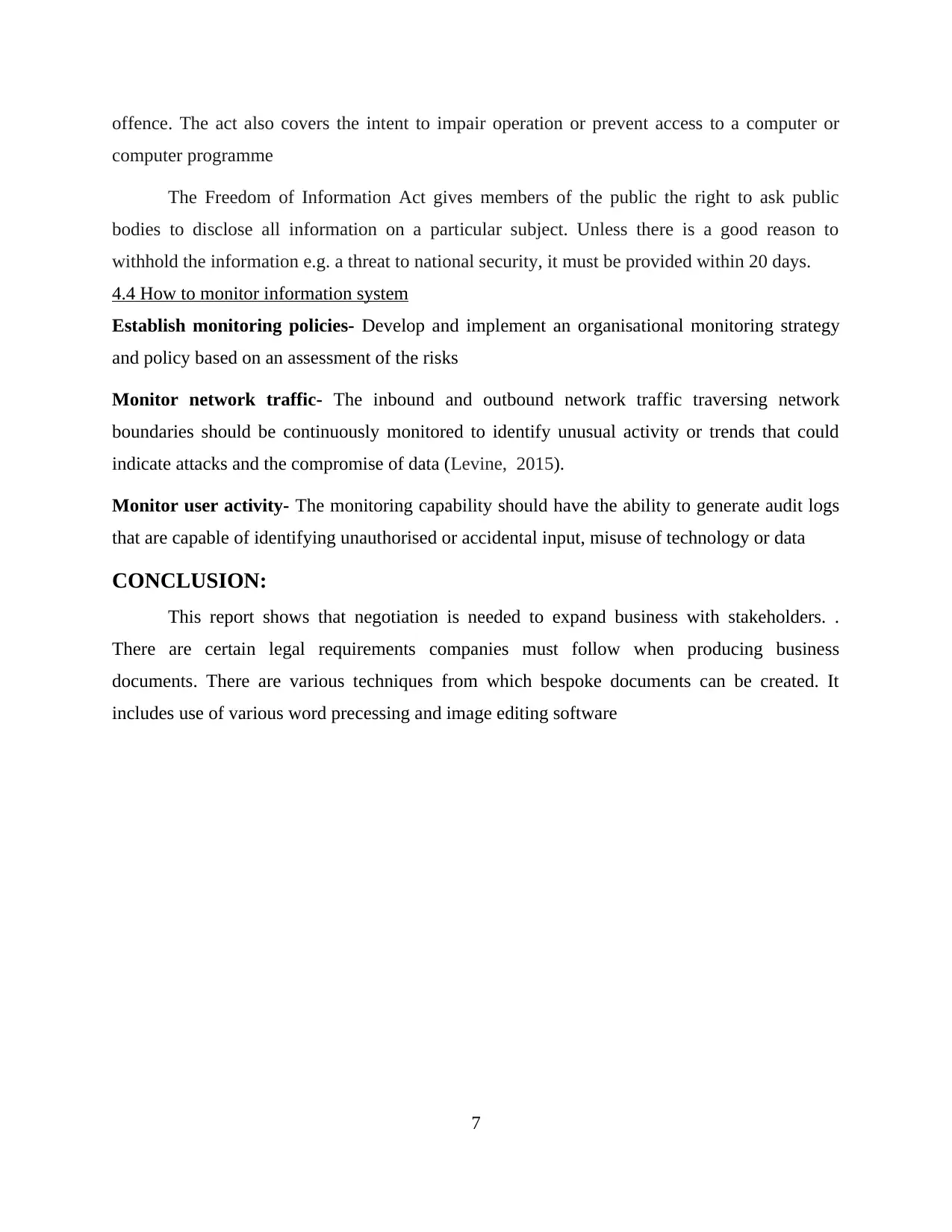
offence. The act also covers the intent to impair operation or prevent access to a computer or
computer programme
The Freedom of Information Act gives members of the public the right to ask public
bodies to disclose all information on a particular subject. Unless there is a good reason to
withhold the information e.g. a threat to national security, it must be provided within 20 days.
4.4 How to monitor information system
Establish monitoring policies- Develop and implement an organisational monitoring strategy
and policy based on an assessment of the risks
Monitor network traffic- The inbound and outbound network traffic traversing network
boundaries should be continuously monitored to identify unusual activity or trends that could
indicate attacks and the compromise of data (Levine, 2015).
Monitor user activity- The monitoring capability should have the ability to generate audit logs
that are capable of identifying unauthorised or accidental input, misuse of technology or data
CONCLUSION:
This report shows that negotiation is needed to expand business with stakeholders. .
There are certain legal requirements companies must follow when producing business
documents. There are various techniques from which bespoke documents can be created. It
includes use of various word precessing and image editing software
7
computer programme
The Freedom of Information Act gives members of the public the right to ask public
bodies to disclose all information on a particular subject. Unless there is a good reason to
withhold the information e.g. a threat to national security, it must be provided within 20 days.
4.4 How to monitor information system
Establish monitoring policies- Develop and implement an organisational monitoring strategy
and policy based on an assessment of the risks
Monitor network traffic- The inbound and outbound network traffic traversing network
boundaries should be continuously monitored to identify unusual activity or trends that could
indicate attacks and the compromise of data (Levine, 2015).
Monitor user activity- The monitoring capability should have the ability to generate audit logs
that are capable of identifying unauthorised or accidental input, misuse of technology or data
CONCLUSION:
This report shows that negotiation is needed to expand business with stakeholders. .
There are certain legal requirements companies must follow when producing business
documents. There are various techniques from which bespoke documents can be created. It
includes use of various word precessing and image editing software
7
⊘ This is a preview!⊘
Do you want full access?
Subscribe today to unlock all pages.

Trusted by 1+ million students worldwide
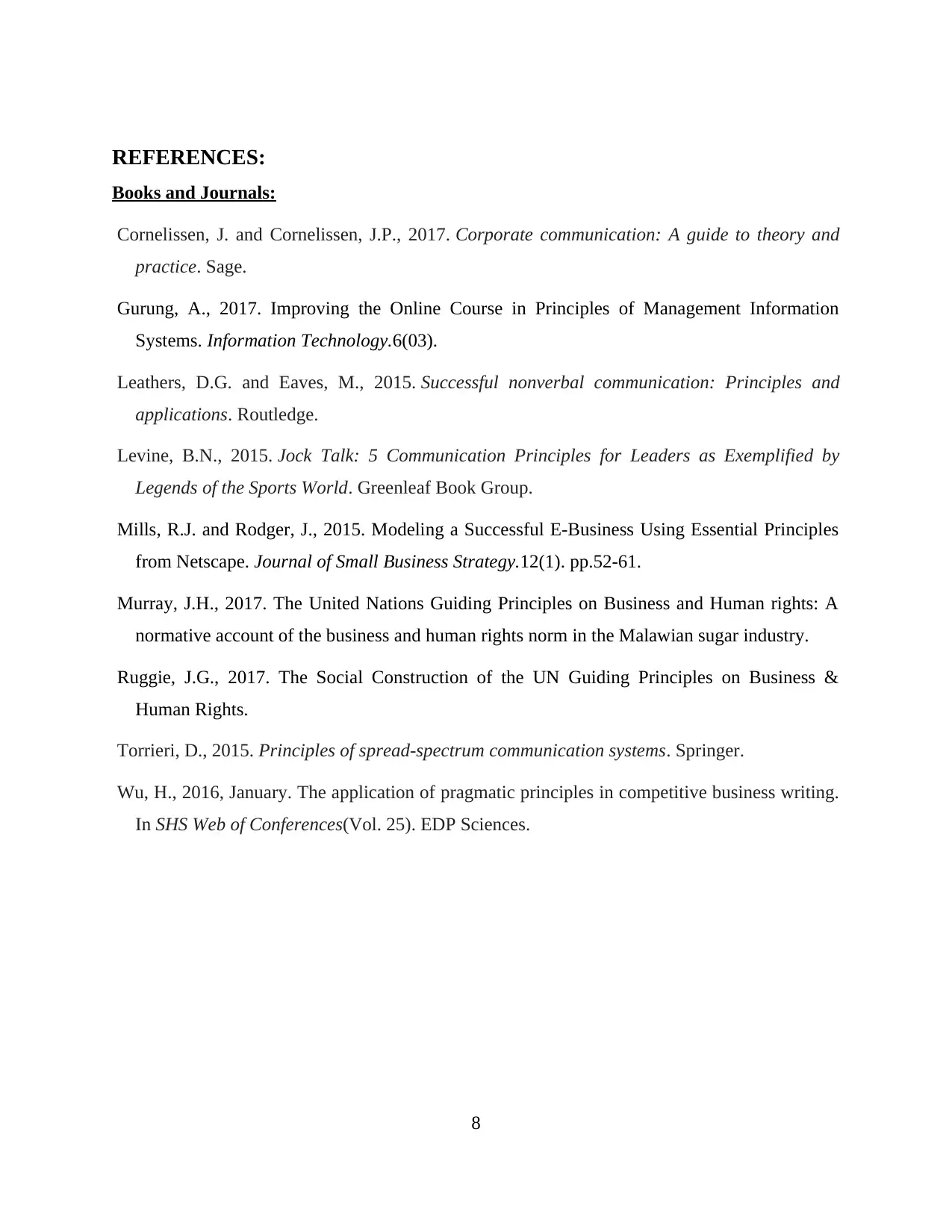
REFERENCES:
Books and Journals:
Cornelissen, J. and Cornelissen, J.P., 2017. Corporate communication: A guide to theory and
practice. Sage.
Gurung, A., 2017. Improving the Online Course in Principles of Management Information
Systems. Information Technology.6(03).
Leathers, D.G. and Eaves, M., 2015. Successful nonverbal communication: Principles and
applications. Routledge.
Levine, B.N., 2015. Jock Talk: 5 Communication Principles for Leaders as Exemplified by
Legends of the Sports World. Greenleaf Book Group.
Mills, R.J. and Rodger, J., 2015. Modeling a Successful E-Business Using Essential Principles
from Netscape. Journal of Small Business Strategy.12(1). pp.52-61.
Murray, J.H., 2017. The United Nations Guiding Principles on Business and Human rights: A
normative account of the business and human rights norm in the Malawian sugar industry.
Ruggie, J.G., 2017. The Social Construction of the UN Guiding Principles on Business &
Human Rights.
Torrieri, D., 2015. Principles of spread-spectrum communication systems. Springer.
Wu, H., 2016, January. The application of pragmatic principles in competitive business writing.
In SHS Web of Conferences(Vol. 25). EDP Sciences.
8
Books and Journals:
Cornelissen, J. and Cornelissen, J.P., 2017. Corporate communication: A guide to theory and
practice. Sage.
Gurung, A., 2017. Improving the Online Course in Principles of Management Information
Systems. Information Technology.6(03).
Leathers, D.G. and Eaves, M., 2015. Successful nonverbal communication: Principles and
applications. Routledge.
Levine, B.N., 2015. Jock Talk: 5 Communication Principles for Leaders as Exemplified by
Legends of the Sports World. Greenleaf Book Group.
Mills, R.J. and Rodger, J., 2015. Modeling a Successful E-Business Using Essential Principles
from Netscape. Journal of Small Business Strategy.12(1). pp.52-61.
Murray, J.H., 2017. The United Nations Guiding Principles on Business and Human rights: A
normative account of the business and human rights norm in the Malawian sugar industry.
Ruggie, J.G., 2017. The Social Construction of the UN Guiding Principles on Business &
Human Rights.
Torrieri, D., 2015. Principles of spread-spectrum communication systems. Springer.
Wu, H., 2016, January. The application of pragmatic principles in competitive business writing.
In SHS Web of Conferences(Vol. 25). EDP Sciences.
8
1 out of 10
Related Documents
Your All-in-One AI-Powered Toolkit for Academic Success.
+13062052269
info@desklib.com
Available 24*7 on WhatsApp / Email
![[object Object]](/_next/static/media/star-bottom.7253800d.svg)
Unlock your academic potential
Copyright © 2020–2025 A2Z Services. All Rights Reserved. Developed and managed by ZUCOL.





